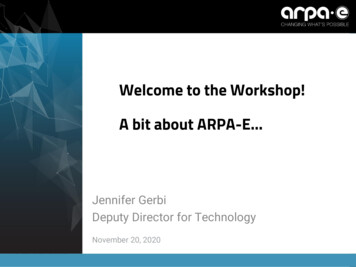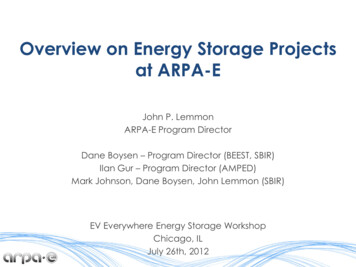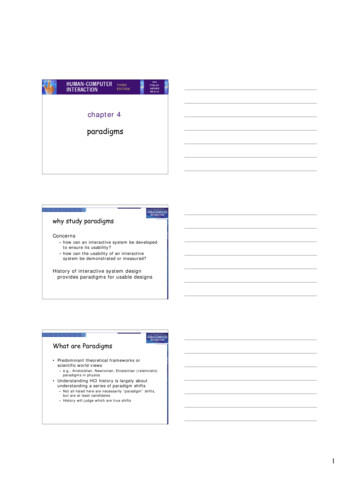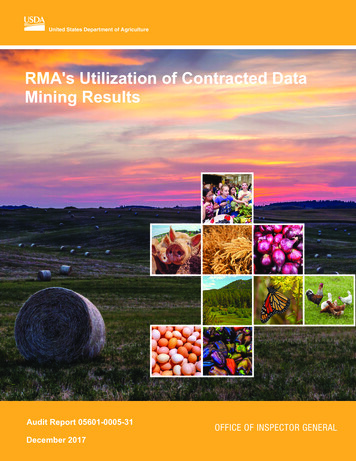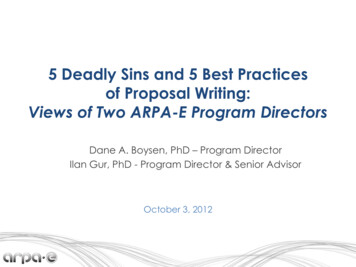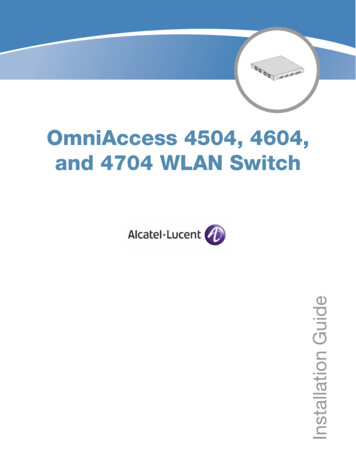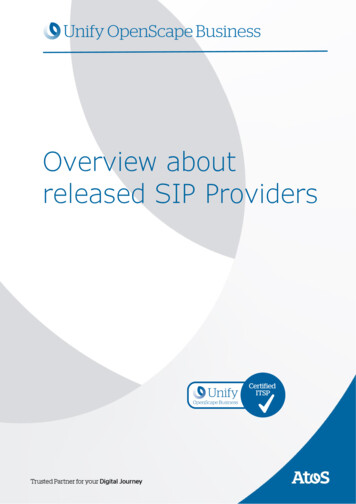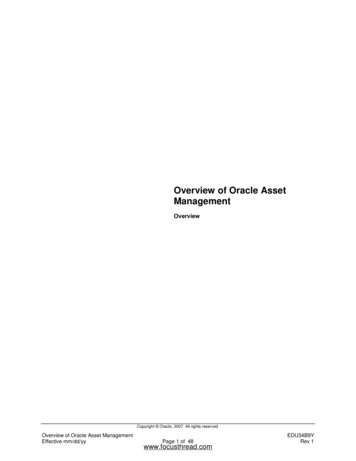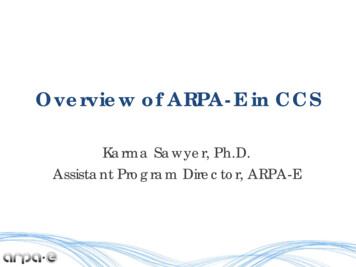
Transcription
Overview of ARPA-E in CCSKarma Sawyer, Ph.D.Assistant Program Director, ARPA-E
Evolution of ARPA-E2011American Recovery& Reinvestment Act2012Funding of 275 MM2009AmericaCOMPETES20072006Rising Above theGathering Storm(National Academies)2009 / 201020112012Open 65Open 3Projects12060TBDDollars(MM) 366 156TBDPrograms2
ARPA-E MissionTo enhance the economic andenergy security of the U.S.To ensure U.S. technological leadin developing and deployingadvanced energy technologies3
ARPA-E ortsImproveEnergyEfficiencyAdvanced Transformative Technologies4
Creating New Learning CurvesR&D forBreakthroughTechnologies toCreate NewLearning CurvesCost ( ) /PerformanceCurrent Learning Curve(Assured Path)Scale in Size or Volume5
ARPA-E is currently running four FOAs - three focusedand one broadMethane Opportunities forVehicular Energy (MOVE)Open FOABiofuelsVehicle Storage Home Refueling 2000GridtransmissionWindAdvanced Managementand Protection of Energystorage Devices (AMPED)SolarFuel cellsGrid scale storageConventionalgenerationEnergy Storage SBIR/STTRTechnical Areas of Charge Program ObjectivesOffline Diagnostics for Rapid Model Validation6
MOVE ProgramMethane Opportunities for Vehicular EnergyObjectives 5-yr payback for light duty natural gas vehiclesConformable tanks with energydensity CNGConvenient, low-cost at-homerefuelingVehicle Storage Home Refueling 2000Program director: Dane BoysenEst. award date: Sep 2012No. projects:7-10Investment: 30MApproach 1: Low pressure storage ( 500 psi) Sorbent materials with energy density CNGApproach 2: High pressure storage (3,600 psi) High strength, conformable tanks low cost compression7
12 Focused e EfficiencyMOVEHEATSBEETITStationary PowerIMPACCTADEPTGRIDSSolar ADEPTGENIREACT
Billion kilowatt-hoursU.S. electricity generation projectionsSource: EIA Annual Energy Outlook (2011)9
Worldwide electricity projectionsWorld electricity generation (trillion kilowatt-hours)Source: EIA International Energy Outlook (2011)10
Capture is the largest costCapturePost CombustionOxy-fuelPre ageSaline AquifersEORDeep SeaEnergycomparison, withparasitic load %Adapted from Herzog, Meldon, Hatton, Clean Air Task Force (2009)11
Two Approaches to Reduce Capture CostsAdvanced MaterialsInnovative ProcessesTexas A&MATKHigh risk, high reward projects that can disruptivelylower the energy needs & cost structure for capture12
Where ARPA-E Fits in with CCS13
Carbon capture projects from FOA-1 andIMPACCT: 49.4M in fundingFunding by categoryFunding by entity type
CO2 capture process using phase-changingabsorbentsPhase-changing materials; allowexploration of unconventional tradeoffsbetween OPEX and CAPEX. Preliminaryeconomic assessments are promising.Solids handling; team hasovercome early limitationsand has a unique desorptionprocess.
High-Throughput (HT) Metal-Organic Framework(MOF) DiscoveryHT surface area measurements Correlate NMR relaxation times tosurface area – faster than BET Robotic instrumentation used withsingle-sided NMRHT sorption isotherms Before: 8 weeks to measure 28 MOFs Now: only 1 day to measure the samenumber Next step: Gen 2 system that measures28 samples at a time with mixed gases16
Cryogenic Carbon CaptureClean GasOutDe-sublimation; CO2 from flue gas is removed bya classical separation process. The SES teamoffers a creative approach with a unique valueaddition for energy storage.FlueGas InFinal target integrated unit operations campaigns on real flue gasMulti-stage contactor; flue gas isfractionated in a high surface-areastaged configuration.
A 10,000 GPU Selective Membrane for CO218
Robust Metal-Organic Frameworks (MOFs) andPorous Polymer Networks (PPNs)Functionalized PPNsPCN-200 Chemically, thermally robust Selectivity 200 Simple, inexpensive synthesis
IMPACCT Summary 49.4 M Federal Funding (all ARRA funding) 17 projects in post-combustion capture ( 44.4 M)1 project in chemical looping demonstration atNCCC ( 5 M) 2-3 years of funding per project, average 2.2M Start at TRL 2-3 (lab scale)Finish at TRL 4-6 and transition to NETL or commercialgroupsMost projects finish between fall 2012 and fall 201320
Related Oral PresentationsWednesday afternoon Codexis – Directed evolution of carbonic anhydrase catalysts LLNL – Catalytic Improvements of Solvent Capture Systems ATK / ACENT Labs – Supersonic duct for solid CO2 separation RTI – Non-aqueous solvents ORNL / Georgia Tech – Hollow-fiber ionic liquid sponges21
Evolution of ARPA-E 2 2006 Rising Above the Gathering Storm (National Academies) Ameri
